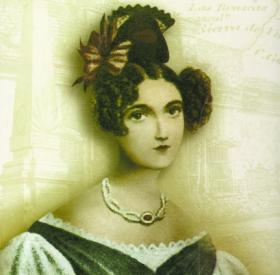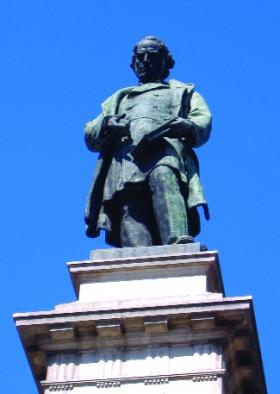Camila O’Gorman: a rose among the thorns
Published in 18th–19th - Century History, Features, Issue 4 (Jul/Aug 2008), Volume 16
Camila O’Gorman, twenty years old and eight months pregnant when executed on 18 August 1848 in Santos Lugares. (Mario Blanco and María I. Linares, from a daguerrotype by Leon Pallière)
On the morning of 18 August 1848, in the town of Santos Lugares in the north-west of the Buenos Aires province, two figures sat side by side, tied to chairs and blindfolded in front of a firing squad. Death did not come instantly. The soldiers were nervous and failed to shoot straight, for they knew that in a country where there was no shortage of executions this one was different. On one side sat Camila O’Gorman, a beautiful twenty-year-old who was eight months pregnant, and on the other sat Father Uladislao Guitierrez, her priest. Their crime?—to have fallen in love.
The love that these two had for each other was of a pure nature, beyond political or financial considerations: a flickering flame of innocence and freedom within the darkness of a brutal and oppressive society, and worthy of a classic romantic novel. But the reality of the times left little place for such dangerous notions, and there were precious few happy endings. At the head of a patriarchal system consisting of church, family and state towered the ominous presence of Juan Manuel Rosas, a wealthy landowner who had seized absolute power in 1835 and who, in common with other South American dictators, maintained his control of the country with a savage ruthlessness, indiscriminate torture and killing, along with an extensive network of secret agents and spies. He was noted for his horsemanship, his cunning, his attractiveness to women and his penchant for displaying the severed heads of his enemies on pikes around the main square of Buenos Aires. Those who managed to escape with their heads intact were mostly in exile in Uruguay, where they plotted and planned his downfall. Even today people in Argentina are bitterly divided over the historical legacy of this man whose features adorn their twenty-peso note: a national hero who helped to unite the country and keep the European imperial forces at bay, or a merciless tyrant and murdering thug. While there is perhaps a little truth in both, he certainly possessed many of the attributes of the latter. It is ironic that this seemingly all-powerful despot, who was to end his life in poverty on a farm outside Southampton, England, was brought down largely through his daughter Manuelita’s best friend, who, although fearless and well connected to the upper echelons of Buenos Aires society, was at the end of the day a mere woman: Camila O’Gorman.
The couple’s elopement, and the ensuing drama, began during the night of 11 December 1847 and enraged Rosas. It was not that he personally was of a straitlaced nature, having something of a reputation with women and having fathered five children by his maid and mistress, Maria Eugenia. Perhaps if they had come to him with their problem something could have been quietly arranged, but this running off together was a flagrant defiance of his public role as the moral guardian of society. Arrayed alongside him were other powerful forces, all men and mostly Irish, or of Irish descent. Camila’s own father, Adolfo O’Gorman, a strict disciplinarian obsessed with religion and morals (partly, perhaps, because his own mother’s dalliances with the French viceroy had set tongues a-wagging), described their elopement as ‘the most atrocious and unheard-of event in our country’. Father Anthony Fahy from Loughrea, Co. Galway, chaplain to Irish Catholics in the country and friend and ally of Rosas, called for exemplary punishment to be meted out to the young woman who had brought such scandal upon her community.

Juan Manuel de Rosas, caudillo (dictator) of Argentina, still adorns the 20-peso bank note.
At first the fleeing lovers had fortune on their side. After a torturous journey they finally found refuge in the town of Goya, in the province of Corrientes, where under false names they were known as two young teachers setting up the town’s first school. The next six months, during which they were immensely popular with the local population, would be the happiest of their short and tragic lives. Unwittingly, however, they had become pawns in someone else’s game; elsewhere the story was taking on a political dimension, with Rosas’s enemies in Uruguay making the most of it to highlight the moral degradation of his regime.
Their betrayer arrived in town in the form of Father Miguel Gannon, a distant cousin of Camila’s and a nephew of Admiral Brown (the Irishman who founded the Argentine navy), who immediately recognised the couple and informed the governor. They were placed under arrest and transported to Santos Lugares to meet their fate. In desperation Camila wrote to her friend Manuelita, Rosas’s daughter, begging her to intervene. But the mind of the dictator was made up by the fact that the lovers showed no signs of contrition, claiming that their actions were no crime but in fact had been blessed by the sanctity of love. This flagrant defiance of his wishes was for him the last straw. Another Irishman stepped onto the stage to play a leading role in the final scene. Dalmacio Velez Sarsfield (a descendant of Patrick Sarsfield, the hero of Ballyneety), who would eventually provide Argentina with its first civic code, provided the legal justification for the illegal act of shooting a pregnant woman. As a finishing grotesque touch to the tragedy, Camila was made to drink holy water before being shot, so that her baby should be baptised and rise to heaven.

Monument in Córdoba to Dalmacio Velez Sarsfield (a descendant of Patrick Sarsfield)—he provided the legal justification for the illegal act of shooting a pregnant woman. (Pablo D. Flores)Monument in Córdoba to Dalmacio Velez Sarsfield (a descendant of Patrick Sarsfield)—he provided the legal justification for the illegal act of shooting a pregnant woman. (Pablo D. Flores)
The execution turned out to be an act of political suicide by Rosas. Its barbaric savagery caused a wave of popular revulsion, and the opposition in Uruguay quickly changed their tune: the pair whose actions had previously been denigrated as scandalous and disgraceful metamorphosed into ‘doomed lovers’. Rosas was finally defeated at the battle of Caesars in 1852 and sent into exile. He is buried on Southampton Common, England.
There is concrete testimony to the majority of the characters involved in this tragedy, the male ones at least. Whip out a twenty-peso note from your back pocket and you are faced with the legacy of Juan Manuel Rosas. Go to Recoleta cemetery and it’s hard to avoid the ornate granite features of Father Fahy, surrounded by harp-bearing angels, in a position of eternal glory across from his compatriot Admiral Brown. Even Dalmacio Velez Sarsfield has a football club named after him. But what about Camila? There have been books and poetry, films, even an appropriately doomed Broadway musical that was due to open on 11 September 2001, but that’s it. No statues, no streets or plazas in her name, and precious little in the history books.
Oscar McLennan is a performer, writer and translator.
















